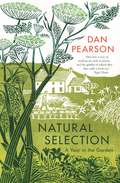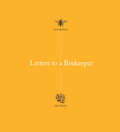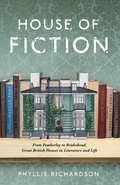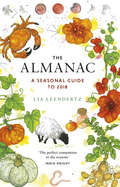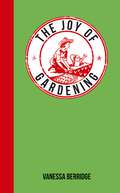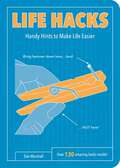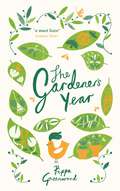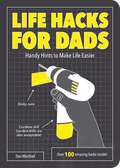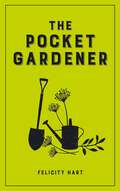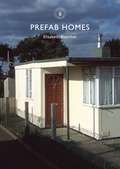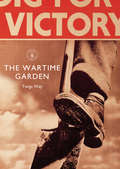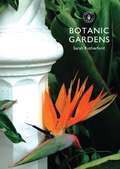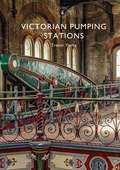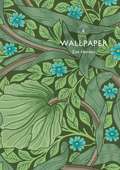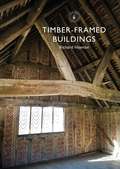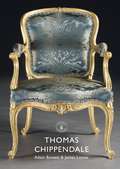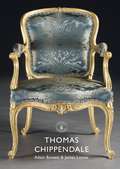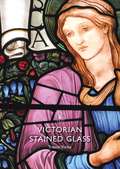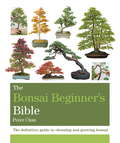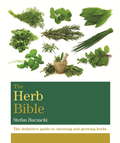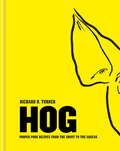- Table View
- List View
Natural Selection: a year in the garden
by Dan Pearson"When it sings, a garden will have the power to transport and to lead you to a place that is magical. It is an oasis for creation, available to anyone with a little space and the compunction to get their hands dirty."In Natural Selection, Dan Pearson draws on ten years of his Observer columns to explore the rhythms and pleasures of a year in the garden. Travelling between his city-bound plot in Peckham and twenty acres of rolling hillside in Somerset, he celebrates the beautiful skeletons of the winter garden, the joyous passage into spring, the heady smell of summer's bud break and the flaring of colour in autumn. Pearson's irresistible enthusiasm and wealth of knowledge overflow in a book teeming with tips to inspire your own space, be it a city window box or country field. Bringing you a newfound appreciation of nature, both wild and tamed, reading Natural Selection is a deeply restorative experience.
Letters to a Beekeeper
by Alys Fowler Steve BenbowThis the story of how, over the course of a year, Alys, the Guardian gardening writer, learns how to keep bees; and Steve, the urban beekeeper, learns how to plant a pollinator-friendly garden.Part beautifully designed coffee-table book, part manifesto, this collection of engaging letters, emails, texts, recipes, notes and glorious photos creates a record of the trials, tribulations, rewards and joys of working with, rather than against, nature. And along the way, you will pick up a wealth of advice, tips and ideas for growing food and keeping pollinators well fed. Letters to a Beekeeper is for lazy gardeners, novice beekeepers and everyone in between. It is the best rule-breaking, wildlife-friendly, guerilla, urban gardening, insect-identifying, honey-tasting, wax-dripping, epistolary how-to book you could ever hope to own.
The House of Fiction: From Pemberley to Brideshead, Great British Houses in Literature and Life
by Phyllis RichardsonHouses in literature have captured readers’ imaginations for centuries, from Gothic castles to Georgian stately homes, Bloomsbury townhouses and high-rise penthouses. Step on to a tour of real and imagined houses that great English writers have used to reflect the themes of their novels… houses that became like characters themselves, embodiments of the social and historical currents of their time.Phyllis Richardson takes us on a journey through history to discover how authors’ personal experiences in their homes helped to shape the imaginative dwellings that have become icons of English literature:Virginia Woolf’s love of Talland House in Cornwall is palpable in To the Lighthouse, just as London’s Bloomsbury is ever-present in Mrs Dalloway. E.M. Forster’s childhood home at Rook’s Nest mirrors the idyllic charm of Howards End. Evelyn Waugh plotted Charles Ryder’s return to Brideshead while a guest at Madresfield. Jane Austen was no stranger to a manor house or a good ballroom. And Horace Walpole’s ‘little Gothic castle’ in Twickenham inspired him to write the first English Gothic novel, The Castle of Otranto.But the English country house, from the idyllic to the unloved, is also viewed through a modern lens – Kazuo Ishiguro’s Darlington Hall, Ian McEwan’s Tallis House, Alan Hollinghurts’s Two Acres.Using historic sources, authors’ biographies, letters, news accounts, and the novels themselves, The House of Fiction presents some of the most influential houses in Britain through the stories they inspired, while offering candid glimpses of the writers who brought them to life.
The Almanac: A Seasonal Guide to 2018
by Lia LeendertzThe Almanac revives the tradition of the rural almanac, connecting you with the months and seasons via moon-gazing, foraging, feast days, seasonal eating, meteor-spotting and gardening. Award-winning gardener and food writer Lia Leendertz shares the tools and inspiration you need to celebrate, mark and appreciate each moment of the year.
The Joy of Gardening (The\joy Of Ser.)
by Vanessa BerridgeThis pocket-sized miscellany, packed with quirky facts, quotes, handy hints and surprising stories is the perfect pick-me-up for anyone who knows the incomparable joy of gardening.
Life Hacks: Handy Tips to Make Life Easier (Life Hacks Ser.)
by Dan MarshallEver accidentally used your thumb as a hammer cushion while putting up a picture hook? Dozens of everyday dilemmas are solved with Life Hacks. This fully illustrated manual covers everything from nifty electric cable management to ingenious cooking methods and much, much more.
The Gardener's Year
by Pippa GreenwoodThis beautifully illustrated guide contains specific month-by-month ‘to do’ lists for ornamental gardens, edible crops and general maintenance, as well as tips on things to look out for, such as pests and how to eliminate them.
Life Hacks for Dads: Handy Hints to Make Life Easier (Life Hacks Ser.)
by Dan MarshallLife Hacks for Dads is your handy guide to making your daily life that little bit easier. This fully illustrated manual covers everything from keeping your car door wonderfully dent-free to making sure your kids stay entertained, and much, much more.
The Pocket Gardener
by Felicity HartBrimming with curious garden lore as well as practical, year-round advice on everything from planting and pruning to growing your own veg and composting, this handy book is the perfect companion for any gardener. Whether you’re seeking inspiration or information, The Pocket Gardener will keep you busy in all seasons.
From Darkness to Light: Writers in Museums 1798-1898
by Rosella Mamoli Zorzi;Katherine ManthorneFrom Darkness to Light explores from a variety of angles the subject of museum lighting in exhibition spaces in America, Japan, and Western Europe throughout the nineteenth and twentieth centuries. Written by an array of international experts, these collected essays gather perspectives from a diverse range of cultural sensibilities. From sensitive discussions of Tintoretto’s unique approach to the play of light and darkness as exhibited in the Scuola Grande di San Rocco in Venice, to the development of museum lighting as part of Japanese artistic self-fashioning, via the story of an epic American painting on tour, museum illumination in the work of Henry James, and lighting alterations at Chatsworth (to name only a few topics) this book is a treasure trove of illuminating contributions. The collection is at once a refreshing insight for the enthusiastic museum-goer, who is brought to an awareness of the exhibit in its immediate environment, and a wide-ranging scholarly compendium for the professional who seeks to proceed in their academic or curatorial work with a more enlightened sense of the lighted space.
Prefab Homes (Shire Library #788)
by Elisabeth BlanchetAt the end of the Second World War Winston Churchill promised to manufacture half a million prefabricated bungalows to ease the housing shortage; in the end more than 156,000 temporary 'prefabs' were delivered. Nicknamed 'Palaces for the People', and with convenient kitchens, bathrooms and heating systems, they proved popular and instead of being demolished as intended they were defended by residents who campaigned to keep their family homes and communities. Nearly seventy years later, as the last of these two bedroom homes are being demolished, Elisabeth Blanchet tells the story of these popular dwellings and their gardens and shows the various designs that were produced. Through the stories and memories of residents, she also reveals the communities who were pleased to live in the prefabs.
The Wartime Garden: Victory (Shire Library)
by Sarah Rutherford Twigs WayThis War is a Food War…' In 1941 Lord Woolton, Minister for Food, was determined that the Garden Front would save England: 'Dig for Victory' was the slogan, digging for dinner the reality. With food imports dwindling the number of allotments grew, millions opted to 'Spend an Hour with a Hoe' instead of an hour in a queue, and the upper classes turned lawns, tennis courts and stately gardens over to agriculture. The national diet was transformed, with swedes grown in the place of oranges and hapless children sucking on carrot lollies; evacuees grew their own meals and bomb sites sprouted allotments. Vegetables ruled the airwaves with Mr Middleton's 'In Your Garden' whilst Home Guard potatoes became the favourites of the Kitchen Front. This is a fully illustrated look at the time when gardening saved Britain.
Botanic Gardens (Shire Library)
by Sarah RutherfordAcross the world hundreds of botanic gardens combine scientific research, conservation and beauty with public access, with Kew Gardens alone attracting around one million visitors a year. For centuries they have variously focused on cultivating medicinal and exotic plants, introducing lucrative crops such as tea and rubber to new countries, preserving international plant collections, scientific classification and research – or have combined all these things. Sarah Rutherford here tells their story from the sixteenth-century up to their long heyday in the last two hundred years. She explains the gardens' design and architecture, the personalities and institutions associated with them, their important role in research and conservation, and their appeal to millions of visitors.
Victorian Pumping Stations (Shire Library #846)
by Trevor YorkeVictorian pumping stations are colourful cathedrals of utility. Their imposing and striking exteriors enclose highly decorative cast-iron frames, built to encage powerful steam engines. They are glorious buildings which display the Victorians' architectural confidence and engineering skills. More than that, they represent a key part of the story of urban development and how our towns and cities were shaped in this period of ground-breaking invention and civic pride. In this illustrated guide, Trevor Yorke tells the story of Victorian pumping stations and explains why they were built in such a flamboyant manner, describing their architectural features and showing how their mighty steam engines worked. He includes examples of their glorious interior decoration from pumping stations across the country and provides a detailed list of those which are open to visitors.
Victorian Pumping Stations (Shire Library #846)
by Trevor YorkeVictorian pumping stations are colourful cathedrals of utility. Their imposing and striking exteriors enclose highly decorative cast-iron frames, built to encage powerful steam engines. They are glorious buildings which display the Victorians' architectural confidence and engineering skills. More than that, they represent a key part of the story of urban development and how our towns and cities were shaped in this period of ground-breaking invention and civic pride. In this illustrated guide, Trevor Yorke tells the story of Victorian pumping stations and explains why they were built in such a flamboyant manner, describing their architectural features and showing how their mighty steam engines worked. He includes examples of their glorious interior decoration from pumping stations across the country and provides a detailed list of those which are open to visitors.
Wallpaper (Shire Library)
by Zoë HendonWe agonise and argue when choosing it; we admire, compliment and criticise it (or keep politely quiet about it); and the rest of the time we don't even notice it. Wallpaper has been the backdrop to our homes for hundreds of years. It can make a house feel cosy or trendy, modern or traditional, and it is one of the key elements of home décor through which to express personal taste. Despite the threat from plain-painted minimalism, wallpaper maintains a strong presence in modern domestic decoration. Zoë Hendon traces the history of wallpaper in Britain and its foremost designers, examining how social mobility and new technologies have influenced design trends. From early Chinoiserie, through William Morris and on to the 'feature wall', this book looks at wallpaper's surprisingly controversial place in shaping our sense of home.
Wallpaper (Shire Library)
by Zoë HendonWe agonise and argue when choosing it; we admire, compliment and criticise it (or keep politely quiet about it); and the rest of the time we don't even notice it. Wallpaper has been the backdrop to our homes for hundreds of years. It can make a house feel cosy or trendy, modern or traditional, and it is one of the key elements of home décor through which to express personal taste. Despite the threat from plain-painted minimalism, wallpaper maintains a strong presence in modern domestic decoration. Zoë Hendon traces the history of wallpaper in Britain and its foremost designers, examining how social mobility and new technologies have influenced design trends. From early Chinoiserie, through William Morris and on to the 'feature wall', this book looks at wallpaper's surprisingly controversial place in shaping our sense of home.
Timber-framed Buildings (Shire Library)
by Richard HaymanTimber-framed buildings are a distinctive and treasured part of Britain's heritage, with such noteworthy examples as Little Moreton Hall, Anne Hathaway's Cottage and Lavenham Guildhall. The oldest are medieval but their numbers peaked in the sixteenth and seventeenth centuries, with a revival in the nineteenth. The majority of timber-framed buildings are houses, but wood was used in all kinds of other buildings, including shops, inns, churches, town halls and farm buildings.In this beautifully illustrated book, Richard Hayman outlines the history of timber-framed designs, and considers the techniques used in their construction, the regional variations in style that can be found, and how these buildings displayed social status. He also guides the reader in identifying structures now concealed behind later work and explores how these buildings have been treated in subsequent centuries.
Timber-framed Buildings (Shire Library #879)
by Richard HaymanTimber-framed buildings are a distinctive and treasured part of Britain's heritage. The oldest of them are medieval but their numbers peaked in the sixteenth and seventeenth centuries, with a revival again in the nineteenth. The majority of timber-framed buildings are houses, but timber was used in all kinds of other buildings, including shops, inns, churches, town halls and farm buildings. This book outlines the history of timber-framed buildings, including their construction techniques, regional variations in style, and their social status. It also shows how the buildings have been treated in subsequent centuries and guides the reader in identifying timber-framing that is concealed behind later work. Illustrated with colour photographs, it is the ideal primer for anyone interested in timber-framed buildings who wants to explore them further.
Thomas Chippendale (Shire Library)
by Adam Bowett James LomaxFor at least 150 years, Thomas Chippendale has been synonymous with beautifully made eighteenth-century furniture in a variety of styles – Rococo, Chinese, Gothic and Neoclassical. Born in Otley, Yorkshire, in 1718, Chippendale rose to fame because of his revolutionary design book, The Gentleman and Cabinet Maker's Director, published in 1754. That same year he set up his famous workshops in St Martin's Lane, creating some of the most magnificent furniture ever made in Britain. This beautifully illustrated history focuses on Britain's most famous furniture maker and designer, including the worldwide phenomenon 'Chippendale style' that became popular in Europe, North America and Asia after his death in 1779. Today, his influence lives on with the ongoing production of 'Chippendale' furniture, while the eighteenth-century originals are selling for millions at auction.
Thomas Chippendale (Shire Library)
by Adam Bowett James LomaxFor at least 150 years, Thomas Chippendale has been synonymous with beautifully made eighteenth-century furniture in a variety of styles – Rococo, Chinese, Gothic and Neoclassical. Born in Otley, Yorkshire, in 1718, Chippendale rose to fame because of his revolutionary design book, The Gentleman and Cabinet Maker's Director, published in 1754. That same year he set up his famous workshops in St Martin's Lane, creating some of the most magnificent furniture ever made in Britain. This beautifully illustrated history focuses on Britain's most famous furniture maker and designer, including the worldwide phenomenon 'Chippendale style' that became popular in Europe, North America and Asia after his death in 1779. Today, his influence lives on with the ongoing production of 'Chippendale' furniture, while the eighteenth-century originals are selling for millions at auction.
Victorian Stained Glass (Shire Library)
by Trevor YorkeA beautifully illustrated guide to the world of Victorian stained glass and its manufacturers and designers.Victorian stained glass – magnificent, colourful and artistic – adorns countless British churches, municipal buildings and homes. Across the decades, several artistic movements influenced these designs, from the Gothic Revival, through the Arts and Crafts Movement and into Art Nouveau as a new century dawned. Historian Trevor Yorke shows how craftsmen re-learned the lost medieval art of colouring, painting and assembling stained glass windows – but also, in this age of industry, how windows were templated and mass produced. Showcasing the exquisite glass generated by famous designers such as A.W.N. Pugin, Pre-Raphaelites William Morris and Edward Burne-Jones, and by leading manufacturers such as Clayton and Bell, this beautifully illustrated book introduces the reader to many wonderful examples of Victorian stained glass and where it can be found.
The Bonsai Bible: The definitive guide to choosing and growing bonsai (Octopus Bible Ser.)
by Peter ChanThe Japanese and Chinese have been creating bonsai trees for centuries and it is now an internationally popular pastime. This compact and stylish guide will provide everything you need to know to grow bonsai successfully, including shaping with wires, watering, seasonal maintenance, tackling common ailments, choosing the right container, feeding and repotting. A directory of over 90 of the most popular species, illustrated with beautiful photographs, will enable you to find the tree that is right for you.
The Herb Bible: The definitive guide to choosing and growing herbs (Octopus Bible Ser.)
by Dr Stefan BuczackiDiscover more than 130 herbs in this authoritative and attractive reference book by horticultural expert Stefan Buczacki. There is at-a-glance information on a wide range of herbs with advice on how to grow them and their best uses - both culinary and ornamental. Designing and planning a herb garden is also considered, with advice on site, soil and style.
Hog: Proper pork recipes from the snout to the squeak
by Richard H. Turner'If you're after advice on what to do with any cut you can think of, look no further.'The Caterer 'Hog is a bible for pork fans everywhere...the book celebrates the versatility, appeal and - most importantly - the taste of the pig.'Great British FoodHog is a celebration of all things pig - from breeds and rearing, to butchering and preparing, with techniques, features and more than 150 recipes for nose to tail eating. The comprehensive range of dishes includes hams, bacon, sausages, charcuterie, pates, confits, roasts, grills, hotpots, ragouts, pies, casseroles, scratchings, crackling, trotters and much more - with a foreword from Josh Ozersky and guest contributions from a range of British, American and International chefs and cooks including Diana Henry, Meredith Erickson, Judy Joo, Valentine Warner, Neil Rankin, Mitch Tonks, Fergus Henderson and Aaron Franklin.
